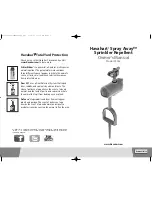
Subject to change · FNA1HV 005_008_016_43622600 · 0421· EN
Page 16
www.argo-hytos.com
9
Operation of the off-line filter unit
9.1
Filtering hydraulic fluids in the bypass flow.
›
Attach the filter unit as described under point 7 and connect it (with 3~ motors observe direction of rotation).
›
When using a suction bell or a suction and pressure lance resp., immerse these into the hydraulic tank of the machine or system.
›
Depending on the connection, the filter unit can be switched on automatically (with the machine or system) or manually.
›
Control of the oil flow (sufficient immersion depth of the strainer or the suction lance resp. into the hydraulic fluid).
›
Check the element for clogging, using the clogging indicator.
Risk of malfunctions!
›
When connecting the off-line filter unit hydraulically, a strainer must be inserted on the suction side.
›
A missing strainer can lead to the destruction of the pump. In this case, the manufacturer assumes no liability.
›
When installing the off-line filter units, a contamination indicator must be used.
›
Without a clogging indicator, element clogging cannot be detected.
CAUTION
9.2
Ensuring maximum cleaning performance
›
Start up hydraulic or lubrication system (circulation of fluid, lower viscosity).
›
Keep the distance between the suction and pressure sides as large as possible (no short-circuiting of the oil flow).
›
Keep an adequate filtration time - recommended guideline values:
90 minutes per 100 l / 26.4 gal tank capactiy with FNA1HV 005 devices
60 minutes per 100 l / 26.4 gal tank capactiy with FNA1HV 008 devices
30 minutes per 100 l / 26.4 gal tank capacity with FNA1HV 016 devices
›
At the beginning of filtration, it may take a few seconds to fill the filter unit.
›
To prevent an oil flow short circuit, the distance between the suction bell or the suction and pressure lances
should be kept as large as possible.
NOTE
















































